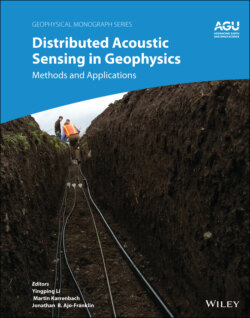Читать книгу Distributed Acoustic Sensing in Geophysics - Группа авторов - Страница 16
1.1. DISTRIBUTED ACOUSTIC SENSOR (DAS) PRINCIPLES AND MEASUREMENTS
ОглавлениеIn this chapter, we consider the principles and performance of distributed and precision engineered fiber optic acoustic sensors for geophysical applications (Hartog et al., 2013; Parker et al., 2014). In particular, system parameters such as spatial resolution, dynamic range, sensitivity, and directionality are examined for seismic and microseismic measurements.
In this first section, we consider the measurement principle of DAS, which uses naturally occurring random scatter centers along the fiber. We use the term acoustics in a broad physical sense here, like any propagation of mechanical disturbances (Lewis, 1985). We review different DAS systems, including direct‐intensity‐detection and phase‐detection schemes, where we derive a mathematical relationship for optical phase recovery. Our aim is to explain the nature of the distributed acoustic signal and describe the natural limitations for DAS measurements. Such information is needed to optimize DAS recording parameters for geophysical applications. Examples of DAS parameter optimization for seismic applications can be found in Section 1.2. We also present some examples of active and passive seismic field data in Sections 1.2 and 1.3.
Figure 1.1 Operation principle of distributed acoustic sensing.
